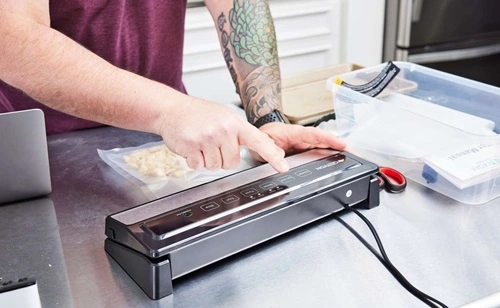Vacuum sealers for food have won praise for their power to keep foods’ original appearance, taste, texture, and health benefits. After the food items are placed in the bag, the tool draws in air from the vicinity and utilizes a heated sealing bar to tie the bag’s sides together.
This mechanism prevents freezer burn by preventing the loss of moisture, which is the main cause of this condition, and it also prevents spoilage in the pantry. Due to the presence of oxygen, lipids will get rancid if not stored in an airtight container or bag.
If you’re debating whether or not investing in a meal vacuum sealer would be worthwhile, consider these uses. More and more people are joining food co-ops, CSAs, and farmer’s markets in an effort to cut costs when buying groceries.
To delay spoilage, you can either put the item away or eat it quickly after buying it. Vacuum packaging is a convenient and secure way to keep perishables fresh for longer.
Here are some of its advantages and disadvantages

Advantages
Saves time
Food may be stored in the freezer for later use, so it’s a good idea to cover and freeze leftover meals, snacks, and veggies. When the mealtime rolls, just whip up your appropriate number of servings and put the portions you want in the skillet and cook them in a water bath until they are tender. The meal is complete.
Saves money
Meat can be stored for up to six months if you buy it in bulk, cut it into serving sizes, and then seal the containers. Savings over time purchasing meat at the grocery store for every meal are enormous.
Helps in storing food
To keep food from spoiling, vacuum machines eliminate the possibility of microbial growth. When food is vacuum-sealed, the oxygen is removed. Without oxygen, microorganisms like fungi and bacteria die.
Protects food
In the freezer, food can dry up and even burn if it isn’t properly packaged, but vacuum packaging eliminates this risk. When food is frozen and water gets into it, it causes freeze burn. The vacuum seal provides an effective barrier it against elements because the food is not exposed to the air and so does not lose any of its moisture.
Prolongs service life
If you vacuum-seal your food, it will last much longer in the fridge. Food stored in a vacuum container has a shelf life that is three to five times that of the same food stored in a plastic bag or container. Whether food is kept in the fridge, freezer, or pantry affects how long it takes to eat up.
Food lasts for longer
Frozen meals that are vacuum sealed will survive an average of two to three years, while other types will last an aggregate of 6-12 months. Most vacuum sealed foods have a life span of two weeks in the fridge, which is substantially longer than the standard life span of 2 – 3 days when normally stored in the fridge.
Great food organization
Vacuum sealing guarantees a neat and tidy package. Foods that have been vacuum sealed take up less room in the fridge or freezer and may be easily viewed without opening the packaging.
Keeps food airtight
Freezer burn is avoided by vacuum sealing because it creates an airtight condition for food. Vacuum packaging keeps food tasting fresh for long months after being stored because it prevents moisture loss.
Food tastes much better
Moisture, juices, and flavor are all preserved via vacuum packaging. The flavor is obviously different.
Keeps food safe
When food is vacuum-sealed, the majority of the oxygen is removed, preventing the chemical reactions that lead to spoilage. It also keeps spoilage microorganisms from building up in food.
Keeps food fresh
Food that has been vacuum sealed has a reduced risk of deteriorating, as well as avoiding the appearance of a slime film or unpleasant odor while storage in the freezer.
Liquids can also be stored
It will stiffen a little in the freezer, so put the liquid there for a while. Then, using a sealer bag, transfer the liquid to the freezer, making sure there is enough space at the top of sealing the bag. Liquids can be preserved by vacuum sealing a container.
Seals scraps
Immediately remove any debris from your food by vacuuming it. This manner, you may save money by avoiding food waste, and you can save time by preparing a quick supper.
You might not need to have the same thing for dinner 3 nights in a row if you freeze the leftovers; they will keep for months in the freezer. It will still taste great when you take it out after some weeks later.
You can reseal
To prevent the chips from being crushed, a vacuum meal sealer is useful for resealing them. Place the bag (top straight) into the sealer, leaving a few inches of space at the top, and push the seal button.
Seal snacks and trail mix
Pack and seal individual servings of trail mix or other snacks. The portable, snack-sized portions are convenient for storing in a bag or box and taking along for an on-the-go energy boost.
An easy way to make sure your food stays as fresh as possible after being vacuum-sealed is to date it. The date of storage can be used as a guide for when the food should be consumed.
The shelf life of food can be increased by washing it properly before keeping it. Clean any surfaces used for packaging in between uses to avoid spreading germs. If you’re looking to get your pantry in order and your food preserved, get the best food vacuum sealer which can offer all the merits.
Disadvantages
Need special bags
Bags designed for use with vacuum sealers are necessary for both automated and manual models. It is recommended that they be stronger and more substantial than typical plastic grocery bags.
Due to their semi permeable nature, plastic bags that aren’t made to be vacuum sealed may still let air in. Food stored in a vacuum but stored in a conventional plastic bag will not last any longer than it would in the original packaging.
All the bags are not reusable
Non-reusable bags, resealable but not reusable bags, and reusable and sealable bags are the three primary categories of vacuum-sealed storage bags.
As a general rule, stores will only stock non-reusable bags. These are disposable bags that don’t have a zipper like Ziploc brand ones.
There are also single-use bags that can be sealed before disposal thanks to a zipper closure.
Bags that can be partially reused and sealed again could be utilized with an air pump. These airtight bags can be sealed with a zipper and deflated using a one-way valve. This bag is compatible with both standard and high-end vacuum sealers.
To be fair, although, reusable bags don’t hold up very well over time, eventually the zipper system and the one-way valve will give out.
Expensive
Inexpensive vacuum sealers are not readily available. To vacuum seal your food, you should expect to pay around $80. The commercial quality versions can cost up to $350. Despite the availability of less expensive alternatives, such solutions are limited to use with smaller bags.
Due to their limited durability, vacuum-rated bags will need to be replaced regularly.
Anaerobic bacteria may thrive
Spoilage is caused by the presence of oxygen and moisture, two things bacteria require to multiply. It’s commonly believed that removing air from food by vacuum sealing it will prevent spoilage and bacteria growth.
There is a form of bacteria known as anaerobic bacteria that grows in oxygen-depleted settings. Food poisoning, paralysis, and most critically mortality can all be caused by Clostridium botulinum because of the toxins it produces.
Can’t seal delicate food
Cakes, soft crust breads, and meringues, among other similar items, should not be vacuum sealed. If you vacuum seal a container, all of the air inside will be removed. Because there are no longer any air pockets, the baked goods fall apart. And because of the vacuum seal, the food’s texture is altered and diminished as its being squished.
Inappropriate for vacuum sealing are several types of green vegetables. Additionally, they are more prone to be destroyed than vacuum-sealed. Leafy greens’ decomposition might be hastened by bruising.
Not all food can be vacuum sealed
Foods that are picked at their peak of freshness do not need to be vacuum sealed. But the ethylene that plants give off on their own will keep fruits and vegetables ripening until they perish. Bananas, apples, and apricots are just a few examples. Fruit ripens more quickly in vacuum bags because the gas ethylene cannot escape.
Vegetables of the Brassicaceae family, like cauliflower, broccoli, and Brussels sprouts, can spoil more quickly if vacuum sealed. Other veggies, such garlic and onions, might also threaten the safety of vacuum bags.
Fresh food should not be vacuum sealed. Enzymes in fresh produce cause it to mush when exposed to moisture.
Hina Abbasi is Editor and a passionate sports and entertainment content writer at WinnersMaze.com. Hina’s expertise spans across a wide range of sports, and interest in many TV shows allowing her to deliver insightful analysis and compelling stories that resonate with readers.

